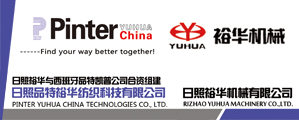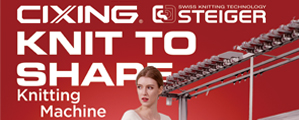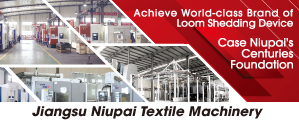Filament weaving industry: appreciating the development of the product and speeding up the pace of t
Jan 29, 2016 | by
Filament weaving industry: appreciating the development of the product and speeding up the pace of transformation and upgrading
Interview with Xu Wenying, president of China Filament Weaving Association
By Xu Yuanyuan
The filament weaving industry was experiencing a slowdown in growth during the 12th Five Year Program period, meaning that the old growth model comes near to an end, which depends on capital input for promoting the rapid development of the industry while the new model is being established, which relies on innovation drive for leading the transformation and upgrading , said Mr. Xu Wenying, vice president of China National Textile and Apparel Council & president of China Filament Weaving Association summarized the filament weaving industry’s performance during the 12th Five Year Program period.
In face of the severe situation of economic recession at home and abroad since the beginning of the 12th Five Year Program period, the filament weaving industry has been striving to make the industry maintain the healthy and stable development by intensifying the efforts on scientific and technological innovation, technology upgrading, accelerating the pace of structural optimization and constantly strengthening the energy conservation and emission reduction, recycling resources in economy, promoting the development strategy of the brand.
According to the statistics, the output of the chemical filament weaving increased by 9.1% annually and the export volume grow by 10.15% per year, so the average annual growth rate of both production and export has reduced significantly in the first 4 years of the 12th Five Year Program period. Generally speaking, the filament weaving industry entered the gear-shift period from its previous rapid-growth history. It is noteworthy that the export for chemical filament fabric is the most outstanding of the textile products, thanks to rich variety of products segmentation and wide-spread use, and moreover, to the products quality that has been increased obviously since the 12th Five Year Program period. The chemical filament fabric is taking a growing market share year by year with the improvement of technical level and product grade. At present, the chemical filament fabric has been basically close to the world advanced level with growing ability in replacing imports.
In terms of product structure, the filament weaving industry steered its way from the expansion of the quantity to the adjustment of the product structure. As a result, the outputs of low-grade products were severely reduced for inventory backlog, and instead, new products with differentiation, functionalization and high simulation (natural fiber-likeness) emerged in an endless stream.
Mr. Xu noted that we should make breakthroughs in the key technologies of fine denier high-density fabric, wide jacquard fabric and inter-woven fabric, promoting the number of assortment and product grade to satisfy the various needs in domestic and foreign markets and to replace the imports. Therefore, the filament weaving industry has become the most dynamic and potential sector in textile industries.
The development of the differentiation product cannot be separated from the support of equipment in the filament weaving industry which is installed with the most efficient water jet looms and air jet looms, and more than 80% of them are water jet looms, the high starting point and the biggest advantage for the product innovation. During the 12th Five Year Program period, the automatic and intelligent level of technical equipment in filament weaving industry has a significant promotion, resulting in the proportion of the weaving machines that reached the international level has increased by 15%, the proportion of the weaving machines with dobby shedding design rises by 30% and larger enterprises have basically installed the dobby shedding mechanism. The automatic drawing-in-and-slasher combination machines have come into use.
In terms of market layout, the filament fabrics are sold both at home and abroad almost at the same pace. As the production goes up, the export volume and market expand synchronously. In 2014, there are 199 direct export countries of the filament fabric (excluding Hong Kong, Macao and Taiwan) with export destinations extending to all over the globe. The trend shows the chemical filament fabrics produced in our country are presented with attractive price and quality, large varieties and designs in, thick, light and high, medium and low-grade portfolios, adapting to a variety of consumer groups and satisfying different consumer market demands for textile fabrics.
In the aspect of energy conservation and emission reduction, the water jet loom wastewater treatment technology increased year by year and the water reuse rate increased from less than 50% to the current 75%. The enterprises that adopted the water reuse technology also increased year by year and reached 15% at present. In case of the increasing production of the filament fabric, the discharge of wastewater produced by the whole industry decreased by 10% and the fresh water consumption reduced 15%.
On the market structure of the filament weaving industry, the fabric expands continuously and extends to home textile industry from clothing field. From the present perspective, the clothing, still the main application, accounts for about 70% of the total market share. The application in home textile field increased year by year and took the percentage of 25%. Xu Wenying pointed out that the industrial area(tech-textile application) has huge development potential, although the percentage accounts merely for 5%, the new field is being explored and more effort will be put on it.
The big data
The production and export volume are increasing slowly and continuously.
In 2014, the total output of chemical filament fabric is 42.5 billion meters and increased by 1.19% year-on-year. The export is about 11.686 billion dollars and increased by 3.65%, the growth rate decreased by 9.5% compared with the same period of last year. The export volume is 11.33 billion meters and increased by 6.35%, the growth rate decreased by 4.83% compared with the same period of last year.
The production and export volume of the chemical filament fabric rank No. 1 of all woven fabrics, excluding the woven fabrics produced in cotton textile mills.
In the first four years of the 12th Five Year Program, the yield increased by 9.1% annually and the percentage of export volume increased by 10.15% per year, resulting in a significant decline in both production and export volume. In general, the average annual growth rate has entered into the period of slowdown in production and export volume during the 12th Five Year Program period.
|
Year |
Production volume |
Export volume | ||
|
Number (billion meters) |
Rate (%) |
Number (billion meters) |
Rate (%) | |
|
2011 |
370 |
23.0 |
95.08 |
23.55 |
|
2012 |
395 |
6.76 |
95.82 |
0.78 |
|
2013 |
420 |
6.3 |
106.54 |
11.18 |
|
2014 |
425 |
1.19 |
113.3 |
6.35 |
The proportion continues to expand
In 2000, export volume of the filament weaving products accounted for 18.6% of the total export volume and up to 36.4% at the end of 11th Five Year Program in 2010. In 2014, the percentage expanded to 42.5% and the filament weaving products have become the first exporting product of the woven fabrics.
The gradual enhancement to replace the import ability
Before year 2000, the import volume of the chemical filament weaving products was increasing continuously with its volume greater than export until the year 2000 that witnessed 2.72 billion meters importing volume, and then decreased annually, reducing to 1.43 billion meters in 2010 and 0.98 billion meters in 2014. In contrast, the export volume remains rapid growth trend; in 2002, the export volume surpassed the import volume for the first time with increasing exports and arrived at 11.33 billion meters in 2014 with the gap of 10.35 billion meters.
The export volume of chemical filament fabric from 2011 to 2014
|
Year |
Import volume (10,000 meters) |
Export volume (100 billion meters) | ||
|
Volume |
Rate |
Volume |
Rate | |
|
2011 |
129600 |
-9.482% |
95.08 |
23.552% |
|
2012 |
117205 |
-9.562% |
95.82 |
0.782% |
|
2013 |
109409 |
-6.652% |
106.54 |
11.182% |
|
2014 |
98229 |
-10.22% |
113.3 |
6.352% |








